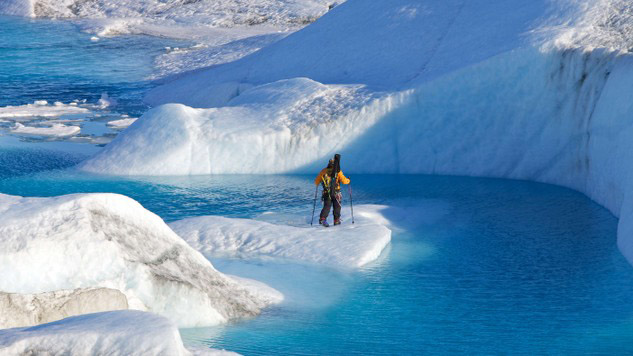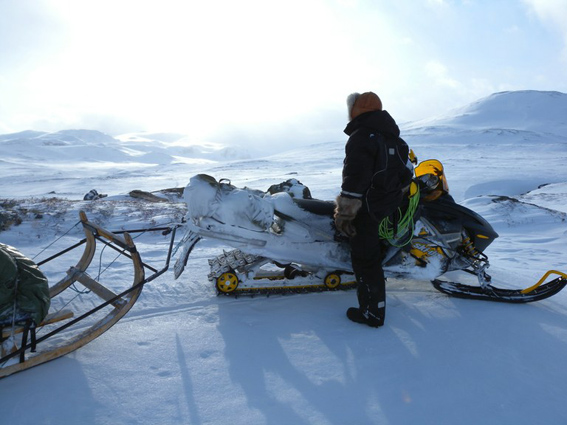The extent of the sea ice in the Arctic reached a new record low in September 2012. Climate change is melting the sea ice in the region at a rate much faster than estimated by earlier projections. The snow cover also shows a downward trend. The melting Arctic might impact not only the people living in the region, but also elsewhere in Europe and beyond. 
Melting glaciers Greenland
“It is clear that our understanding and knowledge of the Arctic and how climate change in the Arctic might impact the rest of the world is improving every year. Science keeps moving forward. The rate of change in the Arctic we observed in the last few years urges us to update policy on a much more regular basis and to ensure that the inter-linkages are properly addressed.”
Prof. Jacqueline McGlade, EEA Executive Director
In the last 20 years, the extent of the summer sea ice in the Arctic has been declining. But at the end of the 2012 summer melt season (end of September), it reached a new record low, which went well below earlier projections. Compared to the yearly average of 6.5 million square kilometres between 1979 and 2010 for September, the Arctic sea ice shrank below 4 million square kilometres in September 2012, which is lower than any minimum value observed in the last three decades.
Speaking at a panel debate on the Arctic melting at the EEA, Professor Peter Wadhams of Cambridge University explained what might have contributed to this year’s unprecedented collapse: ‘Year on year since the late 20th century, the sea ice has been slowly shrinking as the climate has been warming up. The last IPCC estimate from 2007 indicated that summer sea ice would last another 70 years. However, the shrinking has recently speeded up because the ice is getting thinner. Global warming affecting the oceans and the atmosphere caused the ice to grow less during winter.’
The thickness and the age of the ice play an important role in this collapse. Thinner ice melts faster. Wadhams added, ‘Decades ago, the Arctic Ocean was covered almost entirely by multiyear ice, where we had ice more than one year old. Now multiyear ice can only be found in a limited area off the North coast of Greenland and Baffin Island in Canada.’
It is not only the sea ice that is melting in the Arctic. The Greenlandic ice sheet is also losing ice mass at an alarming rate especially at the margins, according to Professor Dorthe Dahl-Jensen from Niels Bohr Institute of Copenhagen University: ‘Compared to the rest of the world, the Arctic has been warming twice as much. The most active glacier in Greenland – the Jakobshavn glacier – used to pour into the ocean at a speed of 7 km per year in 2002, now this has increased to 15 km per year, which means twice the amount of ice is released to the ocean as icebergs which contributes to sea level rise. ’
Speaking at the same event, Dahl-Jensen added, ‘Ice core drilling shows us that we are experiencing exceptionally warm years. We might consider 2012 an extreme event year in climate terms but already in 2010 and 2011 the Greenland ice sheet was losing more than 350 gigatonnes of ice mass per year compared with the average of 240 gigatonnes per year we recorded for 2003-2010. ’
Sea levels on the rise
Greenland’s ice sheet contains enough water to increase global sea levels by 7 metres. In any case, if it were to melt completely, it would take many centuries. Recent melting of the Greenland ice sheet is estimated to have contributed up to 0.7 milimetres a year to sea level rise (about one quarter of the total global average sea level rise of about 3.1 mm/year). Projections for global average sea level rise estimates by 2100 vary from 0.2 to 2.0, depending on the model and scenario used.
‘There is substantial uncertainty around by how much the sea levels may actually increase,’ said Professor David Vaughan from the British Antarctic Survey (and Ice2sea project) during his presentation. ‘Once sea level rises, it is quite difficult to make it fall again. At the moment, the sea level is increasing by about 3 mm per year, but with climate change, this rate is very likely to increase.’
Vaughan continued, ‘There are different factors behind sea level rise. About one third of the rise we can expect could be linked to the thermal expansion of oceans. Melting mountain glaciers are also predictable and their contribution can be estimated roughly. The big uncertainty is linked to ice sheets in Greenland and the Antarctica. We have studies on how they are losing ice, but projections come with high levels of uncertainty.’
According to Vaughan, both the very lowest and very highest estimates of sea level rise are extremely unlikely. He estimates that the middle range (0.4 – 1.0 meter) by the end of this century was more likely. Vaughan also pointed out that sea level rise is not a uniform event; some areas of the world will experience a higher than average rise in sea levels, while other parts will see a fall due to gravitational forces acting differently across the planet. Moreover, sea level rise is not expected to stop at the end of the century. Consequently, policy makers and coastal residents will need to prepare for further rises in the next century.
Vicious cycle
Warmer temperatures in the Arctic accelerate the melting, which result in darker surfaces on the sea and land. These darker surfances retain a larger part of the solar energy instead of reflecting it back. Warmer air and water temperatures in the region also affect the surrounding land, including the permafrost, which has started melting both on land and at sub-sea level.
The Arctic permafrost contains carbon dioxide (CO2) and large amounts methane, which is released into the atmosphere as the permafrost thaws. ‘Methane is a greenhouse gas 20 times more powerful than carbon dioxide. So now we risk facing further global warming and even faster melting in the Arctic,’ added Wadhams.
Arctic livelihoods
In addition to potentially causing sea levels to rise and contributing to global warming, the Arctic melting could also alter the oceans’ salinity levels and affect oceans currents. Moreover, increased absorption of CO2 in the oceans can lead to ocean acidification and this can in turn alter the composition and distribution of key Arctic species like crustaceans, krill and plankton.
According to Morten Olsen, chair of a recent Arctic Council assessment on changes in Arctic snow- and ice-conditions, ‘Changes in the climate and cryosphere risk fundamentally altering the Arctic ecosystems. Warmer water temperatures might result in invasive species moving north, which would affect local species and ultimately local economies.’
Almost four million people live in the Arctic region and have developed their communities and economy to fit their environment. Climate change and warmer temperatures require them to adapt to new conditions.
Tove Søvndahl Pedersen, Head of the Greenlandic Representation in Denmark, highlighted during her presentation day-to-day challenges that people of Greenland have to face because of climate change: ‘As an example, we are currently struggling with an epidemic of mold fungus in our housing stock. An increasing number of homes and public buildings are infected with a fungus, hitherto unseen in Greenland. This has major implications for human health and for our economy.
On the other hand, warmer temperatures also offer new opportunities to the people of Greenland, such as increasing the scope for agricultural production in southern Greenland or in the exploration and extraction of mineral ores, some of which are strategic for climate friendly technologies and have the potential of offering a much needed alternative income as traditional livelihoods cannot sustain the welfare of people. As increases in oil, gas, mineral exploitation and shipping may all contribute to further warming and likely thawing of permafrost releasing methane, Greenland is keenly aware of the need to take a balanced approach.
Beyond the Arctic
The Arctic and the Antarctic act as the planet’s cooling system. This cooling effect, known as the ‘albedo effect’, diminishes when the extent of the Arctic sea ice goes down and the global heat balance is shifted. A warming Arctic could lead to more extreme summers and winters in the Northern hemisphere as it may affect the North Atlantic Oscillation by pushing the jet-stream further south and causing more precipitation.
Because changes to the planet’s cooling system has the potential to change many global systems from weather patterns and oceans streams to species distribution, a melting Arctic will affect not only the people of the Arctic but also the rest of the world population.
Many European cities are built on the coast and, depending on how much sea levels rise, they will need to adapt and prepare. Current storm surge barriers may need to be improved, and erosion may need to be to be managed to maintain coastlines, protect beaches, infrastructure and residential areas. In Europe alone, 70 million people live within 500 meters of the sea and the economic assets have an estimated value between 500-1000 billion Euros. Other parts of the world like Bangladesh or low-lying island states are also at risk from sea-level rise.
‘The challenge is to understand how all these different factors are connected and to continue adapting accordingly alongside reducing greenhouse gasses,’ said Professor Jacqueline McGlade, Executive Director of the EEA. ‘It is clear that our understanding and knowledge of the Arctic and how climate change in the Arctic might impact the rest of the world is improving every year. Science keeps moving forward. The rate of change in the Arctic we observed in the last few years urges us to update policy on a much more regular basis and to ensure that the inter-linkages are properly addressed.’
Climate change impacts in Europe
The EEA recently published a report on the impacts of, and vulnerability to, climate in Europe. The report includes many indicators on changes in the climate system and the cryosphere, indicators of impacts on the environment and society and indicators on changes in the Arctic cryosphere (Arctic sea ice and Greenland ice sheet).
According the EEA report, climate change is affecting all regions in Europe, causing a wide range of impacts. Further impacts are expected for the future, potentially causing high damage costs. The report highlights the need for adaptation in all regions and sectors across Europe. The EEA report supports the European Commission’s European Adaptation Strategy, which will be published in early 2013.
Published Jan 03, 2013
– Courtesy of the EEA






